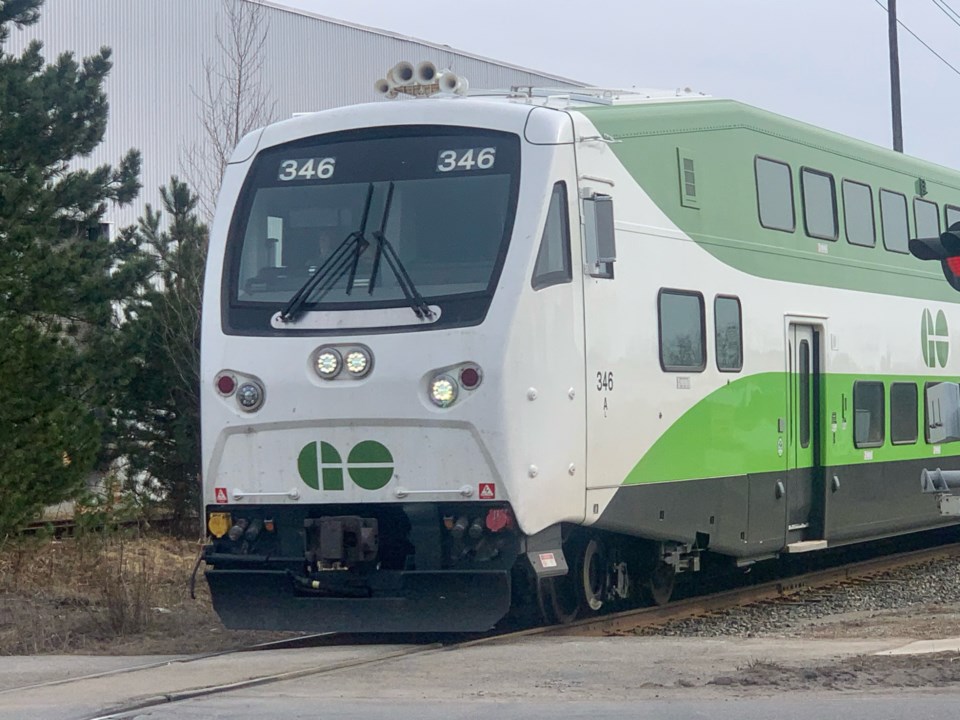As crews “mobilize” to begin work doubling rail tracks from Aurora southward as part of Metrolinx’ goal to provide all-day two-way 15-minute GO Train service along the Barrie line, planners are assuring residents they won’t be “blindsided” at any step along the way.
This was the message that came out of a recent meeting between local residents who live around the GO Station and Metrolinx, which operates GO Transit.
Meeting with members of the Town Park Area Ratepayers’ Association at the Aurora Armoury, Metrolinx’ Jake Schabas said the double-tracking would need to be complete before work begins on a planned vehicular underpass at the Wellington Street station.
“Today, the Barrie corridor is mostly a single-track corridor, so the first enabler of that all-day two-way GO service is to lay the groundwork for that second track,” said Schabas in his presentation to the group. “An enormous amount of work is underway as we speak to do that.”
Among the project components underway or nearing completion is a parking expansion for commuters using the Aurora GO Station, just north of Wellington Street.
Metrolinx in recent years also partially built a pedestrian underpass at the station to connect the existing track to the future second track on the west side of the corridor. This, he said, along with a widening of the Yonge Street rail bridge near the foot of Industrial Parkway South, will be expanded ahead of the all-day two-way service.
“Some work has already begun,” he said. “The second track and the second platform, those crews are just mobilizing.”
Further information will roll out soon, he said, focusing on work scheduled to be completed in one to two-month windows.
“You won’t be blindsided,” he told residents. “We have had a lot of planning work done with the grade separation at Wellington right where the crossing is. This is one of those things we’re working on with ONxpress in the development phase, because a lot of it is tied to exactly what the service, what the signalling looks like, and we’re working through that phase right now.”
Fielding questions about noise factors, vibration impacts, and other elements of the construction project, Schabas said in Aurora he found a “tight-knit” fabric in the Wellington station and Town Park communities, something he said is a testament to the age of the community’s establishment.
“In 2019, before the pandemic hit, we were running approximately 3,500 trips per week [on the GO Network] and this was mostly to serve those rush-hour commuters,” he said. “After the completion of our GO Expansion program, we’re envisioning over 10,000 trips per week. These trains will be running faster and more frequently, with an electrified fleet…. Our aim is to make GO Rail competitive with car driving, not just in the rush hour when things are congested but when the highways and the roads are moving. We believe we can do this with the infrastructure, the systems and the new fleet we’re looking to bring in.
“We’re looking at attracting people away from the highways. We know travel time is important and frequency is important. The GO Rail System is really directly competing with the uses of our highway network, so it is our best alternative, and right now that is our vision, that we want to make sure it is a competitive and attractive service that people actively want to choose.
“This is going to create a lot of jobs, not just during construction but all the economic opportunities this new service is going to create. It is also going to reduce the cost to government of operating our service. We believe that by running these more efficient trains and attracting more riders we’re going to have a better operating business plan that is actually going to cost the government less. At the end of the day this is all about serving customers and making sure the service is attractive. Our vision is about incredibly increasing the number of customers who are using GO Transit.”
Work on the Barrie corridor project was initially envisioned as a 12-year project and at the recent meeting, Schabas said it will take about a decade to complete the network.
“We will have details on the specifics once we get through this development phase but that is roughly the time line we’re seeing this construction taking. It is an enormous undertaking… It is a once in a lifetime type of a program we’re making. I like to compare it to the '50s and '60s, the big investment was building out the 400 series network which transformed the region. Our vision today is this is going to provide that kind of capacity and that future infrastructure that is needed to accommodate the next generations of growth.”
Brock Weir is a federally funded Local Journalism Initiative reporter at The Auroran



